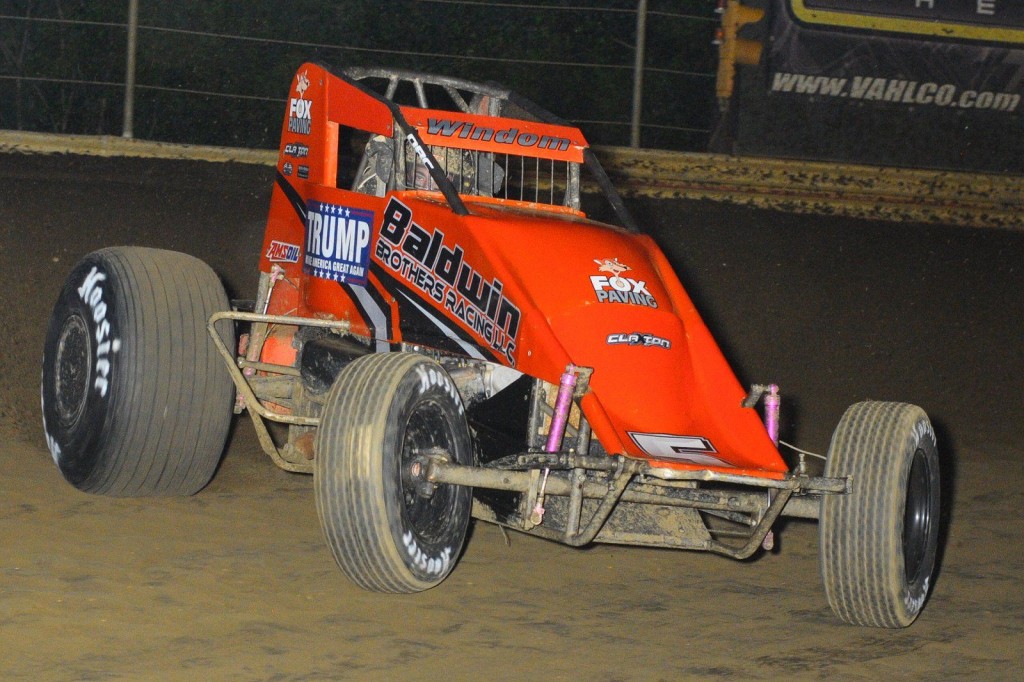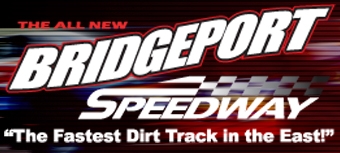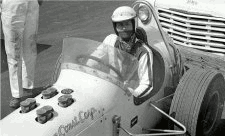Author Archive
2016 USAC Eastern Storm Photos
Posted by: | CommentsBelow are links to our photo galleries from the 2016 USAC Eastern Storm:
June 7 -- Thunder on the Hill / USAC Eastern Storm and 358 Modifieds -- Grandview Speedway
June 9 -- USAC Eastern Storm and NEWS Sprints -- New Egypt Speedway
Congratulations to all feature winners from this past week:
June 7 at Grandview -- Bryan Clauson
June 8 at Lincoln -- Bryan Clauson and Landon Simon (non-points race)
June 9 at New Egypt -- Chad Boespflug
June 10 at Williams Grove -- Chris Windom (Silver Crown)
June 11 at Port Royal -- Bryan Clauson
June 12 at Susquehanna -- Chris Windom
Congratulations to Landon Simon on his first USAC feature win.
2016 USAC Eastern Storm Champion -- Bryan Clauson
USAC National Sprint Car point standings through June 12:
1. Brady Bacon (1105)
2. Thomas Meseraull (1076)
3. Chase Stockon (1014)
4. Robert Ballou (980)
5. Dave Darland and C.J. Leary (953 tie)
Happy Birthday Chris Economaki!
Posted by: | CommentsWe'd like to extend Happy Birthday wishes to Chris Economaki, who turns 90 years old today. Mr. Economaki's contributions to American motorsports journalism are second to none. I personally remember fondly his work at CBS Sports when the network covered NASCAR Winston Cup events and also reading his columns in National Speed Sport News. He certainly made for some of the best Victory Lane interviews.
So Happy Birthday Chris!

Chris Economaki takes some notes at Grandview Speedway, June 3, 2008.
Should IndyCar Have a Fuel Rule?
Posted by: | CommentsIn the wake of Mike Conway's scary crash on the final lap of the Indy 500, Arie Luyendyk is questioning whether the IndyCar Series should require competitors to meet a minimum fuel level through the end of the race. Luyendyk, himself a two-time winner of the 500, believes it's too dangerous for drivers to implement fuel-saving strategies on ovals.
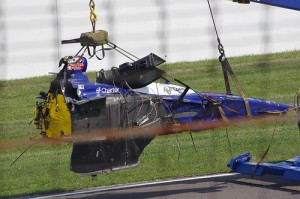
The remains of Mike Conway's car after getting into the fence at Indianapolis. (Mr. 0 photo, flickr.com / CC 2.0)
Conway's car got airborne after clipping the left side of Ryan Hunter-Reay, who suddenly slowed after running out of fuel in turn three on the final lap of the race.
Would this be a good rule to have on the books, or is this just a knee-jerk reaction to an ugly crash?
Imagine for a moment that there was a rule requiring finishers to have at least 1.5 gallons of fuel in the tank after finishing the race, which is apparently similar to what Formula One requires. What if a driver just won the Indy 500 and in post-race inspection the officials were only able to siphon out 1.45 gallons of fuel? What would they say? "Sorry boys... we have to take that trophy away!" Or perhaps the team would just be fined -- which amounts to no deterrence at all. In practice I believe it would be a very unpopular rule.
While I hate that the crash happened and that Conway was injured, we have to admit that it's just something that happens in this sport. Ordinarily the circumstances involved are not a problem: if drivers are too slow they are black-flagged or at least relegated to running on the track apron. Indy is a bit more complicated since the speeds are so fast and there is essentially only one racing lane. Making matters worse, they removed the track apron in 1993 (preferring warmup lanes), taking away a large portion of track that could be used by drivers to avoid an incident or to pull down and out of the way if a problem occurred with the car. Maybe a better question to ask is whether or not Indy cars really need to go a zillion mph in the first place. Does it really put on a better show?
Let's be thankful we got through another oval race without a large portion of a car flying up into the grandstands and keep it at that.
And that reminds me...
What was with all the black-flagging for "blocking" during the Indy 500? Didn't it get a bit excessive? I saw instances where a car was down low and a driver attempted a pass where it was nowhere near humanly possible and still the leading car got a black flag for what amounted to moving over a couple of inches. What happened to finding a way to set the guy ahead of you up for a pass? Or maybe trying to pass on the outside of a straightaway?
If I were a new fan watching that race I would have concluded that if a driver wanted to pass on the inside, it was the lead driver's obligation to move over and let him pass. And we're to believe that the future of Indy car racing is in better hands now that Tony George is gone?
Fan Interference — NASCAR Style
Posted by: | CommentsWith all the recent hilarity surrounding the tasered Phillies fan at Citizens Bank Park, I couldn't help but think about how racing has its share of crazy fans too.
Like this guy.
What ensues when a drunk in the heart of Alabama stumbles upon an unlocked Pontiac Firebird pace car? A police chase right out of the Dukes of Hazzard. Old school NASCAR, man... old school.
Check out that police brutality!
Can Bernard Turn Around Indy Racing?
Posted by: | CommentsI think many, myself included, were a little surprised when the IndyCar Series decided to look outside of the racing world to select its new CEO, Randy Bernard. In fact, Bernard had not even seen an IndyCar race before taking the reins of the series back in March. The move has certainly raised the hopes of many in the racing community that have longed for a new direction for years now. The IndyCar Series was formerly run by Tony George since its founding in 1994. Last year, George retired / was fired by his own mother / up and told the world to pound sand (circle your preferred answer), opening the CEO position up to a fresh face.
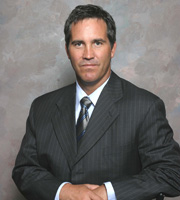
Randy Bernard, CEO of the IndyCar Series. (pbr.com)
Now, to be sure, Bernard brings some mighty fine credentials to the table. He helped build the Professional Bull Riders from nothing to its current level of popularity, which bodes well for Indy racing. But Bernard may be in for one of the biggest professional challenges of his life. For if George -- who had full access to the Indianapolis Motor Speedway cookie jar -- couldn't keep this thing afloat, how will Bernard -- a complete outsider to motorsports -- have the resources and insight to turn it around?
With only two months in, it's obviously impossible to draw any firm conclusions about Bernard's impact on the sport. All we have to go on are the things he's said and done so far. From what I've gathered, this has primarily amounted to 1) A desire to re-connect with grassroots racing while fielding the "best drivers in the world"; 2) Learning and absorbing from Indy car insiders (read: the team owners); and 3) An open mind to try new and different things.
Let's look at each of these things individually, starting in reverse. I pray that trying new things isn't a veiled reference to "The Gimmick". The Gimmick has been employed hastily over the past couple of years, much to the chagrin of anybody with a sense of dignity and uprightness (think red and black tires, power-boost buttons... ohh I don't know... "Danica Mania!"). These silly superficial things only serve to harm the integrity of the sport (though they do generate a hearty laugh, let's give it up for that). Please please please no more gimmicks.
The second point is an easy one. If Bernard is learning the Indy ropes from the team owners, we're doomed. Remember, these are the very people that drove this sport into the ground over the past three decades. To them Indy racing is a hobby you do between jet-setting and eating fine caviar. They are so detached from motorsports reality that the closest they should be to the engineer is in the caboose -- if they should be allowed on the train at all. (Okay except A.J. Foyt, who can be kept on as Sergeant at Arms.)
And that all brings us to the crux of the matter: grassroots racing. And since I feel my blood pressure rising with each sentence I type I'm going to cut to the chase. The problem with Indy racing is NO FANS. That's it. And it amazes me how few people up at the top of the ladder out there in Indiana understand that this is the root problem. No fans. (Okay, "few fans" since I feel generous today.) There are so few fans because there is so little interest in the racing and the drivers have so few fans. NASCAR drivers have more fans on Facebook than IndyCar drivers have fans in the stands.
Imagine if the New York Yankees had no fans. What would that look like? Well the stadium would be empty and the merchandise wouldn't sell and the team would fold up quicker than a cheap camera. But in Indy racing, the team owners think that as long as they have money they can still go out and race and so what's the big deal?
So why has the Indy racing fan base shriveled up? Simply because the racing is so far disconnected from American grassroots racing that Americans just don't care anymore. After years and years of ride-buying and revolving-door drivers the fans have lost interest. So when Bernard talks about having the "best drivers in the world", I sure hope he's talking about the Jeff Gordons and Tony Stewarts rather than the Milka Dunos or he's going to find himself bucked from his seat quicker than Betty White from Bodacious.
In America, grassroots racing is about oval racing. Sprints, late models -- all that good stuff. Dirt, asphalt. Give us a driver that says, "just one of them racin' deals", and we're all good. Drivers we don't know and can't relate to riding around a one-lane temporary street course in downtown Baltimore doesn't float our boat. (Note: Karting does not count as a popular form of grassroots racing. I'm sure it's a great place for drivers to start their careers, but all across the country fans go to see oval racing week in and week out.)
So why don't American grassroots drivers make it into Indy car racing? First is they don't have the money or a sponsor. The second is that their skill -- race cars on ovals -- does not translate well to Indy cars -- which are formula cars on road courses. And because of that they have so few opportunities. So instead they're picked up by the NASCAR teams who can easily secure a sponsorship for them since they can both drive the wheels off their cars and easily relate to fans.
I hear the Indy car is getting a major makeover for the future. Now is the perfect opportunity to develop something that is not designed for road courses. Something that young drivers who cut their teeth on American short tracks can hop into and excel with. Without that connection Indy racing will always be detached from American racing fans and be forced to settle for late-day coverage on the Versus network. And oh yeah... the last time I checked the Indianapolis 500 was an oval race. Let's showcase the best oval drivers in the world.
Best of luck Randy!
Have We Lost Respect?
Posted by: | CommentsThe other day I was watching a 2009 World Series recap special on ESPN and during a break a commercial for ESPN's NASCAR Nationwide Series coverage was shown. The commercial featured scripted (perhaps animated, I can't recall) and dramatized racing action between Nationwide Series cars. Something about the commercial caught my eye and made me think a little bit. Well... two things, actually. The first and less curious thing I noticed is how at various points the commercial paused the action to zoom into a particular driver's sponsor -- Citi, Toyota, etc. I guess that's no big deal but haven't NASCAR's media partners gotten the memo about the sport becoming way too over-commercialized? I mean... an advertisement within an advertisement now?
But that's not important.
The second point was the action itself. Suddenly, out of nowhere, one of the cars that's racing is airborne and twenty feet in the air flipping over. Two other cars are side-by-side and taking the checkered flag as the airborne car follows them. Then the commercial cuts to the punch-line: "NASCAR Nationwide Series on ESPN". Now seriously... doesn't anyone else find that a little creepy?
I can understand an advertisement perhaps using a historical crash to highlight the fact that this sport is a dangerous one and that danger is a part of the draw. It's motorsports -- crashes happen. But to think that somebody sat down and dreamt up his idea of the "best, most awesome finish possible" and came up with this particular vision is a little bit too weird for me.
NASCAR Embraces “MadHouse” Approach to Racing
Posted by: | CommentsNASCAR has either totally lost its mind or is so deep into the pockets of sponsors, team owners and corporate interests that it can no longer see and think clearly. I suspect it's a lot of both and the fact that it could barely muster the courage to put Carl Edwards on a measly three-race probation is evidence of it. Instead of making it firmly clear that NASCAR was in control of its sport, it turned its press statement into an opportunity to express just how concerned it is about the fact that Brad Keselowski's car got airborne after Edwards dumped him. Safety first, after all! NASCAR President Mike Helton explained it: "[Keselowski's car going airborne] is a very important element of all of this that I would ask all of us to be reminded of the fact of the car getting airborne was a very serious issue. And that's something that we'll take a look at very quickly and try to figure out how to help prevent that happening in the future." Way to divert the attention away from the real issue.
And this is where NASCAR's conflicting statements begin. They want to "prevent" an incident like this from happening in the future, yet they've given the drivers the green light to act like complete morons on the racetrack. Does that make any sense at all? Everyone in the racing community is rallying around NASCAR's supposed pre-season pronouncement that drivers are free to "take the gloves off". Did I miss the press release? When did NASCAR say that its drivers had free reign to behave like totally reckless maniacs and wouldn't be punished for intentionally causing violent accidents? If NASCAR thinks that fans are interested in watching their prima donna racers engage in tit-for-tat crashes rather than real racing, then they are even more hopelessly out of touch than I first believed.
NASCAR doesn't understand the simple concept everyone calls "rules". Is it or is it not, by the rulebook, acceptable to intentionally crash somebody? And if it's not, what is the penalty, per the rulebook? Because if the only penalty is a slap on the wrist then Keselowski should be free to send Edwards right over the damn billboards at Texas next month.
Kyle Petty nails it: "I think we took ourselves away from just being a sport to being a sideshow in some ways. We’re not a sport. Sports have rules."
A Tale of Two Carls
Remember last May when Carl Long -- an underfunded driver who was attempting to qualify for a non-points paying race -- blew an ancient and decrepit motor and had it inspected by NASCAR? NASCAR found the motor to be less than two-tenths of a cubic inch larger than the limit. Two tenths. Despite the fact that the violation was almost certainly unintended, they suspended the guy for 12 races, fined him 200 points that he didn't even have, and fined his crew chief $200,000. Twelve races for two-tenths.
Carl Edwards nearly kills someone and he gets "probation" -- which amounts to nothing more than being under the "watchful eyes of NASCAR".
Consistency isn't a NASCAR trademark. Consider:
- In 2007, Robby Gordon was suspended for one race after failing to yield to a black flag that was displayed for aggressive driving in the previous day's Nationwide Series race.
- Ricky Rudd was fined $10,000 and placed on probation for the rest of the season after intentionally crashing Jeff Gordon in the 1994 Mello Yello 500 at Charlotte.
- In October 2004, Dale Earnhardt, Jr. was fined $10,000 and docked 25 championship points for joyfully dropping an s-bomb in a victory lane interview at Talladega. The point loss dropped him from leading the standings.
- At Indianapolis in 2002, Jimmy Spencer intentionally crashed Kurt Busch in what is probably the most dangerous corner in all of American motorsports. Busch was scolded by NASCAR for "gesturing" towards Spencer after climbing from his car.
The Apple Falls Far From the Tree
Unfortunately for NASCAR, Brian France does not seem to be able to command the kind of respect his father and grandfather garnered from its participants. The limp-wristed, "well we're not really sure if that's over the line" approach doesn't exactly exude a sense of strength on NASCAR's part.
It makes me remember a time in 1990 when Dale Earnhardt and Geoff Bodine were wrecking each other consistently until Bill France, Jr. stepped in. The intervention was recalled in the film Days of Thunder. France had lunch with Bodine's then car owner Rick Hendrick and explained: "Rick... If you can't control your drivers any better than this... then maybe you should stick to something you can control. ... Like selling used cars in downtown Charlotte."
